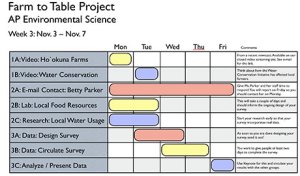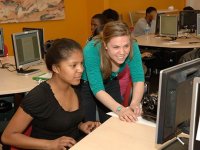The Agile Classroom
While a classroom is different from a startup, certain mindsets and strategies translate well: vision, agility, the right tools, creative thinking, and recognizing individual strengths.
Your content has been saved!
Go to My Saved Content.Agile development refers to an iterative and highly collaborative approach to creating a product. In comparison, an agile classroom is an environment in which your students are motivated to do their best work and feel invested in the class as a whole. Before I started teaching at Punahou School in Honolulu, Hawaii, I was a developer at a startup. We see our own teaching though the lens of our unique experiences, so here are some of the things I learned as an entrepreneur back then that make me a better teacher now.
Have a Vision
There is a tremendous amount of power that comes from a group whose members are all striving toward the same goal and vision, communicated from the top, a goal and vision guiding the team members' daily decisions. Does your classroom have a vision? What is your mission statement? In my classroom, our goal is:
I make sure that I communicate this from the first day of class, and I ask my students to measure whatever they do in class against our shared mission. Will what they're about to do reinforce trust between class members? Is it pro-social? Students should strive to achieve our shared goal in whatever they do.
Be Agile and Nimble
The startup culture exists in a fluid environment, often filled with uncertainty, ready to pivot when necessary. In your classroom, have an open curriculum that can be tinkered with and modified. Even better, allow kids to help to set the agenda and determine the path that makes sense to them as learners. Don't be afraid to make changes to your curriculum midstream. Consider using formative assessment tools like Socrative and Google Forms to solicit ideas from your kids about what direction to take next, or what area of the curriculum to explore. The more involved kids are with creating their curriculum, the more ownership they will feel over the finished product.
Also, study what the "competition" is doing. Collaborate with other classes wherever possible, but more importantly, see how other teachers and classes have tackled this subject or content area. Then ask your students how you could do it better. Looking outward is just as important as looking in.
Use Professional Tools
Startups use professional tools to do professional work. When choosing apps for your classroom environment, focus on what's broader, more powerful, and evergreen -- they can be used by multiple subjects, at different levels. Open-ended apps, such as Explain Everything and Book Creator for iOS/Android, allow kids to develop mastery and express their knowledge and learning in diverse ways.
Students often focus on when a project is due rather than looking at how long a task will take, and working backward to find the appropriate time to start. For more collaborative tasks, especially those tasks that are dependent on others to do their share, when you start is more important than when it is due. Try using a Gantt Chart, often used in startups to coordinate the efforts of team members. The length of each bar indicates the length of time a task should take, and students can easily see which tasks could be done simultaneously. This is a real-world tool that can help students develop real-world collaborative skills.

Create an Idea Factory
At my company, we were encouraged to think creatively and rewarded for coming up with original ideas that helped improve a product or workflow. Find ways in your class to recognize and incentivize innovative ideas. Consider having a class suggestion box, or host a "throw your best pitch" event where each student has two minutes to pitch his or her best idea to the class.
Better yet, create a culture where kids don't have to ask permission. Successful startups don't wait for permission from other companies, and they don't wait for someone else to beat them to the market. Be the first and the best. In my classroom, when we prepared for our own pitch event, kids who had experience making movies held impromptu training sessions to introduce classmates to the app. Other kids formed their own panels to help provide feedback to groups as they rehearsed. These ideas came from the kids themselves, because I had created an environment where they felt encouraged to innovate and empowered to act.
Know Your People
Not everyone has the same skills, and a successful leader has the ability to recognize people's strengths and apply them in different situations to everyone's advantage.
Find ways to get to know your students as individuals, and be creative about using their skills to help the class improve as a whole. In our AP class, for example, students who had previously taken an AP exam held their own test prep sessions with the group, relating what test-taking strategies had been effective. Every student has different strengths; a test like the Bartle Test of Gamer Psychology can help you to identify those strengths so that you can make better collaborative groups. I always try to keep in mind that the best collaborative group project requires students with different skill sets to work toward solving a problem together. If any one of the students in a group could do all the work on his or her own, then it isn't a true group project, just a project that I've given to a group.
The Rewards of an Agile Classroom
In the end, nothing is more memorable than the feeling that you are all working together to accomplish the same goal. To that end, find ways to reward your students for doing the right thing. Have a vision. Recognize achievement in its many forms. Encourage kids to help each other. Find opportunities for rich collaboration. Most of all, challenge your students to work together to accomplish something momentous, build something that matters, and make a difference in the world. That is the most motivating experience of all.
